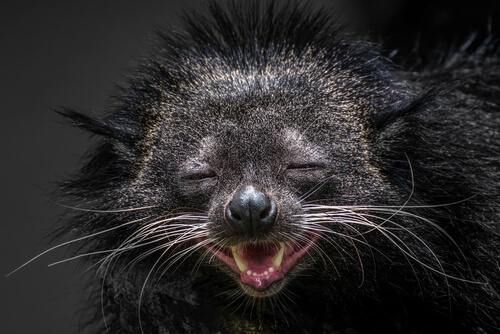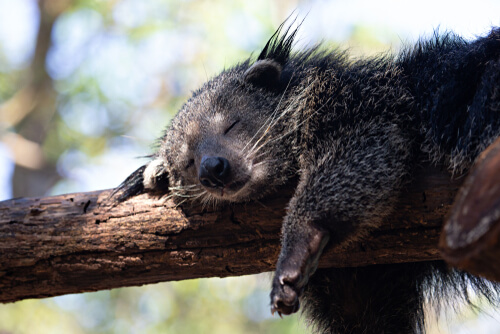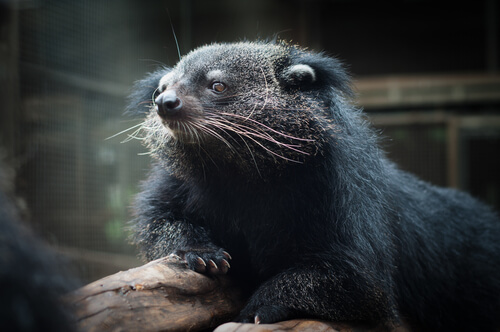
| Kingdom | Animalia |
| Phylum | Chordata |
| Class | Mammalia |
| Order | Carnivora |
| Family | Viverridae |
| Genus | Arctictis |
| Species | Arctictis binturong |
| Niche | Arboreal carnivore |
| Length | 28-33 in (71-84 cm) excluding tail |
| Weight | 23-50 lb (9-20 kg) |
| Lifespan | 18-25 years |
| Social Structure | Solitary, monogamous |
| Conservation Status | Vulnerable |
| Preferred Habitat | Tropical Forest Canopies |
| Average Litter Size | 1-6 |
| Main Prey Species | Rodents, snakes, reptiles, amphibians, insects, fish |
| Predators | Humans |
The Basics
Binturong is a medium-sized tree-dwelling mammal native to Southeast Asia. Also known as “Bearcat”, binturong weighs 23-50 lbs (9-20 kg), making them the largest member of the Viverridae family. They have long, coarse, black, and grey fur over their bodies and large bushy tails. Their tail, measuring 22-35 in (56 to 89 cm), is nearly as long as their bodies, which grow to 28-33 in (71-84 cm) long. Although its range is large, it is uncommon. Populations of binturong are declining and it is listed as “Vulnerable” on the IUCN Red List.
Binturong’s faces have lighter fur than most of their bodies. Their eyes are reddish and small. Binturongs are arboreal, which means they live in the trees. They spend much of their time in the canopies of the tropical forests throughout their range, and can often be spotted sleeping or resting lazily on tree branches. Their nickname, “bearcat”, describes their appearance rather well, as they have some features recognizable from both bears and cats. Although they are the only member of the genus, physically they are similar to Paradoxurus spp. and Paguma spp. as well. Interestingly, Binturong females are about 20 percent larger than males.

A Generalist Hunter
Binturongs are carnivores, so they have relatively large, sharp teeth, including two canine teeth. They will spend most of their time in the treetops in search of prey. However, they will often make their way to the ground as well. They are too large to jump from tree to tree, so they will travel between trees on the ground when necessary. They also swim at times, even diving underwater in search of food. Their diet is varied and includes almost any animal the binturong can find, including rodents, snakes, reptiles, insects, and amphibians. They are nocturnal or diurnal and will usually hunt for their prey at night while resting in the day.

Reproduction
As they are uncommon and difficult to observe in their native treetop habitat, little is known about binturong mating behavior. In 2011, it was observed that the father of a pair remained to aide in raising the young, suggesting they may form monogamous pairs. Females will sometimes form groups with other females and their young, otherwise, binturongs are largely solitary outside of breeding cycles and will actively avoid each other. However, they are not strictly territorial, roaming long distances in search of prey and mates.
Following a 91-day gestation period, females give birth to an average of 2 pups. However, they can give birth to up to 6. Mothers will hide their young in their fur for the first few days of their lives. After 6 to 8 weeks of nursing, the pups will be weaned and take another step towards independence. These young will reach sexual maturity at about 30 months of age for females and 28 months for males. In the wild, binturongs live up to 18 years. In captivity, they have been known to live as long as 25 years.
Fun Facts about Binturong!
Despite their obscurity in the west, the level of interaction between Binturong and humans in Asia is relatively high. Binturongs are often kept as pets or cherished as mice killers. However, in many cases, they are also hunted and poached for their meat and fur.
A Bintu-what?
Binturongs are uncommon and thus not recognized by many people. The name of their genus, Arctictis, actually translates as bear-weasel. However, they have become known as “bearcats” as well. In Indonesia, it is known as “tenturun”. It is a captivating but elusive animal to humans, even if we can’t agree on what to call it.
Do You Smell Popcorn?
Binturong have been described as having a distinct smell similar to that of popcorn or corn chips. This is likely due to an odor they emit from their scent or musk glands. In females, these are on either side of the vulva while in males they are found between the scrotum and penis. These glands produce a musk that contains a compound called 2-acetyl-1-pyrroline which is responsible for this strangely reminiscent odor.
Pets, Poaching and Pest Control
Binturongs have been known to be kept as pets. They are fairly docile and relatively easily domesticated. Unfortunately, they are also sought after by zoos and for still displays making them a target for illegal poaching as well. In some regions, farmers and residents are happy to protect wild binturong as they provide an excellent and low-cost form of pest control. However, they are also sought after for their fur and meat, as it is considered a delicacy in some regions.
Two of a Kind
Along with kinkajous, another arboreal mammal from the rainforest, binturongs are one of only two carnivorous species with a prehensile tail. This means it acts as an appendage and can they can use it grab onto tree limbs. This aids in their movement through the forest canopy. Binturong’s hind limbs are also specially adapted to aid in their movement through the treetops. They rotate entirely backward, allowing their back claws to find a better grip as they climb.
